

|
|||||||
| History of the Boxster |
History of the Porsche Boxster |
| Year to Year Model Changes |
Year to Year Model Changes |
| How to Buy a Boxster |
How to Buy a Boxster  If you are looking to buy a good, reasonably priced Boxster with lots of features, the 2003 and 2004 years would be good choices, particularly this well equipped 2004 550 Spyder 50th Anniversary Edition. Photo Credit - Leonard Turner Editor note, The link is closed. |
| 2004 Porsche Boxster S 50 Years Anniversary Edition |
2004 Porsche Boxster S 50 Years Anniversary Edition As most 550 Spyders were painted silver, the new special edition Boxster S is finished in GT Silver Metallic, a color only found on the Carrera GT and special edition “40th Anniversary 911″ models. The soft top is in Cocoa, a dark brown color used by Porsche for the first time. For additional visual emphasis, wheel spokes are painted in Seal Grey, a colored Porsche crest adorns each wheel hub cover, and the monobloc brake calipers have an aluminum paint finish. Other exclusive exterior styling features include silver-painted grills above the rear strut openings, a specially created stainless steel tailpipe, chrome plated and polished Boxster S lettering on the rear deck lid, and safety bar padding that matches the car’s interior. Cocoa and GT Silver dominate the car’s special interior with matching carpet and floor mats featuring the Porsche script logo. The center panels of the standard heated seats, handbrake lever, gear lever gate, ball-shaped aluminum gearshift knob, inside door handles, and padded sport steering wheel are covered in Cocoa colored leather. The rear section of the center console, handbrake lever, grooved bar on the dashboard, switch panel, and the back of the safety bars are painted in GT Silver Metallic. Instruments are uniquely styled with black faces surrounded by chrome plated decorative rings. Other standard features include Porsche Stability Management (PSM), an on-board computer, Litronic headlamps with dynamic beam angle adjustment and a cleaning system, and a wind stop. The Tiptronic S automatic transmission system, GT Silver seat back shells, and Dark Gray natural leather interior (at no extra cost and with corresponding black top and carpets) complete the short list of options. Production of the new Boxster S edition is limited to 1953 units to commemorate the 550 Spyder’s introduction at the 1953 Paris Motor Show. A limited-edition plate on the center console indicates the Anniversary car’s production number. The two-seater was the first sports car specially designed in Stuttgart-Zuffenhausen with racing in mind. In the years that followed the Spyder, which weighed only 550 kilograms, scored numerous triumphs on racing circuits and in the then popular road races. These successes are a mosaic element contributing to the Porsche brand’s fame and its current familiarity among the general public. The type designation of the racing sports, incidentally, was not derived from its weight as is sometimes assumed. It was, in fact, the 550th Porsche design project. The 550 Spyder has retained a secure place in the hearts of car enthusiasts through its performance in the Carrera Panamericana in 1954. On the fifth and last occasion that the world’s toughest road race was held, Hans Herrmann came third in the overall ranking, directly behind two sports cars with substantially larger engines and won his class. This was followed by countless successes in motor sport, earned by the factory team and by private entrants. The 550 was powered by a four-camshaft 1,498-cc engine developing 110 bhp. This was designed by von Dr. Ernst Fuhrmann, who later became chief executive officer of Dr. Ing. h.c. F. Porsche AG, Stuttgart, and made a significant contribution to Porsche’s racing triumphs right up to the 1960s. The new Boxster S model will go on sale in the United States and Canada in March 2004 at a price of $59,900 US and $85,300 CAN |
| 2008 RS60 Spyder |
2008 RS60 Spyder 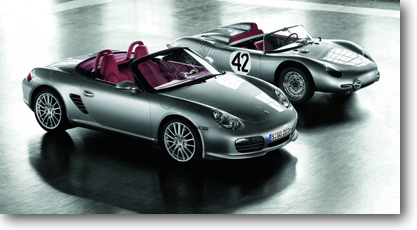 Additional images can be found in the Photo Albums Section
Additional images can be found in the Photo Albums SectionThe new Boxster RS 60 Spyder reflects the sporting character and design purism of that successful mid-engined two-seater sports racing car. The RS 60 Spyder is based on the acclaimed Boxster S model, but differs significantly in terms of its performance and features. Externally, the RS 60 Spyder is distinguished by a unique front spoiler and 19-inch diameter Porsche SportDesign alloy wheels, which spacer plates have moved outwards purposefully in the wheel arches. A modified sports exhaust system combined with dual tailpipes increases engine output to 303 bhp as well as adding further definition to the car's appearance. Completing the sporting orientation to the driving experience is Porsche Active Suspension Management (PASM) which adds further dynamism to the Boxster chassis. Distinctive GT Silver Metallic paintwork is accentuated by the contrasting natural leather interior in Carrera Red. The roof is also finished in red. As an alternative, there is also the choice of Dark Grey natural leather in conjunction with a Black roof. The tail light clusters are also finished in red. Inside, door trim strips made of stainless steel proudly bear the "RS 60 Spyder" model designation. The leather interior trim is further distinguished by a textured surface on the centre sections of the sports seats and the centre door linings, and this also extends to the steering wheel rim and handbrake lever. Completing the sporting ambience is a bespoke gear lever. Complementing the exterior appearance, the faces of the instrument dials have a GT Silver Metallic finish and with this model not having the usual hood over the instrument cluster, the large central rev counter and the two circular dials on either side bring something of the flair of a racing car to the cockpit. Further features include the windscreen surround finished in black, as well as the centre console, the seat backrests and the roll hoops all finished in GT Silver Metallic and thus harmonising with the seat belts also finished in Silver. Reflecting its model designation, the Boxster RS 60 Spyder is limited to 1,960 examples, each one proudly bearing a silver-coloured plaque on the lid of the glove compartment. Market launch of the new Porsche Boxster RS 60 Spyder is starting worldwide in March 2008. Including 19 per cent VAT and country-specific requirements, the retail price in Germany is Euro 63,873, the base price Euro 53,500. |
| 2008 Limited Edition Boxsters |
2008 Limited Edition Boxsters 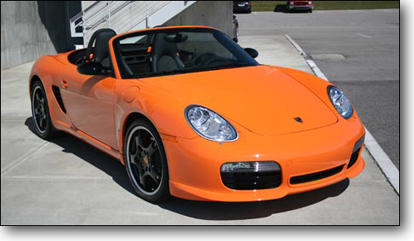 Additional images can be found in the Photo Albums Section
Additional images can be found in the Photo Albums SectionComplementing the orange paint are several eye-catching elements in black including black painted alloy wheels–with large 18 inch standard on the Boxster and 19-inch standard on the Boxster S–striking black exterior side mirrors, black front and side air inlets, all of which tastefully complement the car’s model designation in black on the rear deck and a black convertible top. Black carries over to the seats, carpet, dash, door panels and other surrounding soft surfaces. Adding to the performance theme is the use of Alcantara trim, a suede-like material used on performance Porsches like the 911 GT3 and 911 GT3 RS. Alcantara is pleasant to touch, but it also helps occupants stay planted in the interior during sporty driving. Alcantara trim is used on seat inserts, the three-spoke steering wheel from the 911 GT3 and 911 GT3 RS, and gear shift and handbrake lever on vehicles with manual transmission. To further tie the interior and exterior, Porsche designers added touches of bright orange to interior trim pieces such as the door lever surrounds and the trim panel that covers the dash-mounted cup holders. Even the gray shift pattern on the gear shift lever carries an orange font. |
| 2008 Boxster S Design Edition 2 |
2008 Boxster S Design Edition 2  Additional images can be found in the Photo Albums Section
Additional images can be found in the Photo Albums SectionThe Porsche Boxster S Design Edition 2 (and the Cayman S Sport), will arrive at Porsche Dealers later this fall. And they have a tough act to follow; their predecessors, the Cayman S Porsche Design Edition 1 and the Boxster RS 60 Spyder, have both been very successful. The new Porsche Boxster S Design Edition 2 comes in any color, as long as it’s Carrara White—and that means all over. The starspoke rims of the 19-inch custom SportDesign wheels, the side air intakes, the center console, and the dials of the three round instruments are all painted white. And the unique accessory included in the sales price is also an homage to the whiteness of the tachometer and the speedometer. The Porsche Design men’s watch “Edition 2 Chronograph” from the Dashboard Collection has a white face and was developed especially for this Boxster. The Boxster S Design Edition 2 was released in October of 2008 as a 2008 Model. |
| 2011 Boxster Spyder |
2011 Boxster Spyder 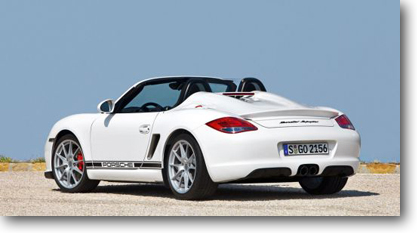 Additional images can be found in the Photo Albums Section
Additional images can be found in the Photo Albums SectionThe Boxster Spyder features a 3.4-liter six-cylinder engine with Direct Fuel Injection upfront of the rear axle. Maximum output is 320 horsepower (hp), 10 hp more than the Boxster S. The combination of 10 more hp and 176 pounds less weight than the award-winning Boxster S, plus an all-new sport suspension that lowers the Boxster Spyder 20 mm, a lower center of gravity, a standard limited slip differential, and exclusive wheels provides the kind of driving dynamics that back up the unique look. Aluminum door skins and lightweight interior door panels from the 911 GT3 RS contribute to the weight reduction. When equipped with Porsche-Doppelkupplung (PDK) transmission and the Sports Chrono Package, the new Spyder, using Launch Control, accelerates from a standstill to 60 mph in 4.6 seconds. Top track speed is 166 mph – with the roof open. Fundamentally, the entire Boxster family is the successor to the legendary 550 Spyder and RS 60 of the Fifties and Sixties, all sharing the same mid-engine roadster concept. Low weight and supreme agility combine to provide outstanding driving pleasure. 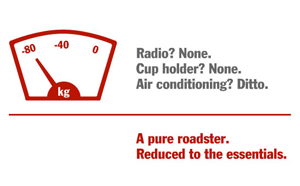 In 2004 and 2008 Porsche produced limited editions of the Boxster bearing the additional name Spyder, honoring the 550 and RS 60. In contrast, the new Boxster Spyder is a regular, but specially developed and upgraded production model as compared with the Boxster and Boxster S. The 2011 Boxster Spyder goes on sale February 2010. U.S. pricing is $61,200. |
| 2016 981 Boxster Spyder |
2016 Boxster Spyder |
| 2016 981 Boxster GTS |
2016 Boxster GTS |
| Gen 1 987 Parts Suppliers |
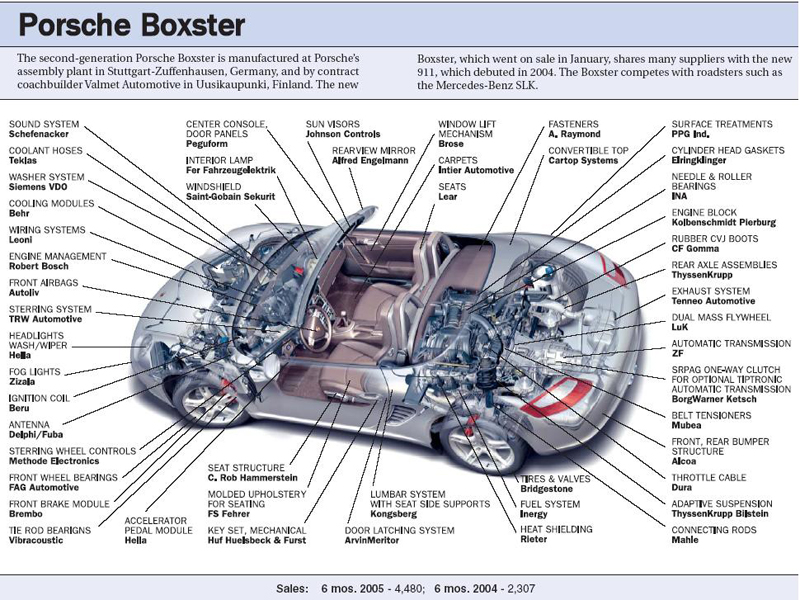 |
| The Boxster Market |
The Boxster Market . A handy guide for those who are looking for a Boxster. https://ww2.pca.org/panoreader/nov-2020/#page=140 |